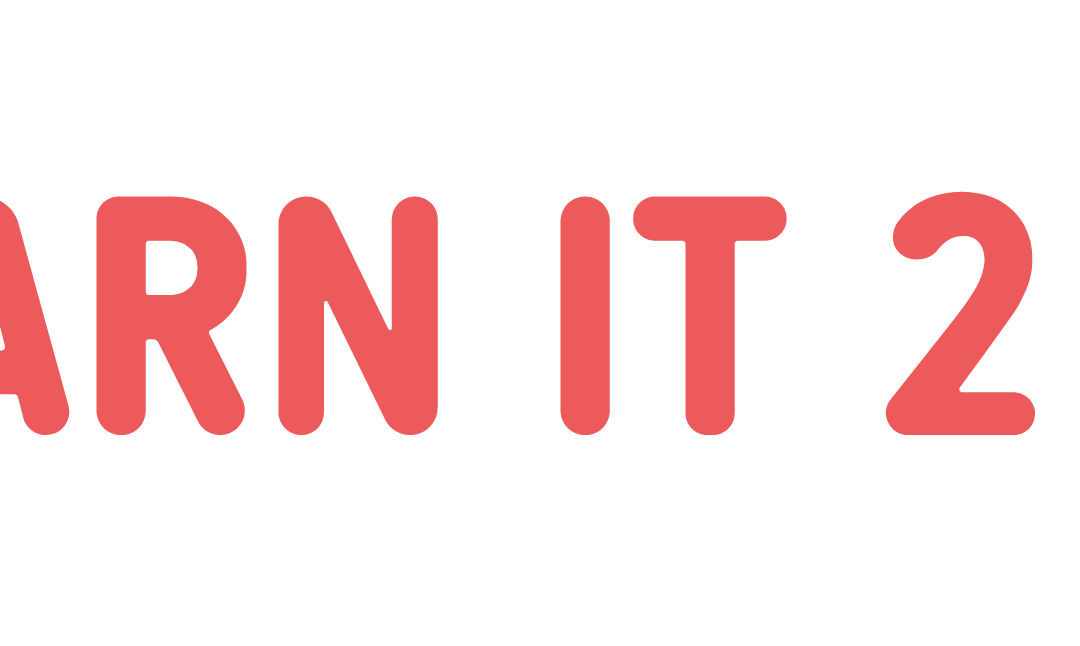
Using Multiplication Tables
Understanding multiplication is one of the foundations of learning any form of mathematics past arithmetic. I remember when I entered my math class in the sixth grade, my teacher spent the first two weeks just going over the multiplication table and testing us on it every day until the entire class hit 100%. At first, he’d hand us 30 questions tests and give us only 5 minutes to complete them, and eventually pushed up to 50 questions with the same amount of time. If we got below 80%, we had a 100 problem worksheet for homework that night.
At the time, I thought it was really silly and extremely unfair. Looking back and reflecting on it now, I realize it was because he was reinforcing one of the most important foundations of math and was setting us up for success in the future. The thing is though, he never really taught us how to multiply. He expected us to memorize the multiplication table (which is also a great approach!) but for some kids, it’s also important to explain the process to them.Kids are inquisitive by nature and want to learn, we just need to find the right way to teach them.
The standard multiplication table is a grid ranging from 0 to 10 that shows the relation of two numbers and their multiplied values. Check the example below
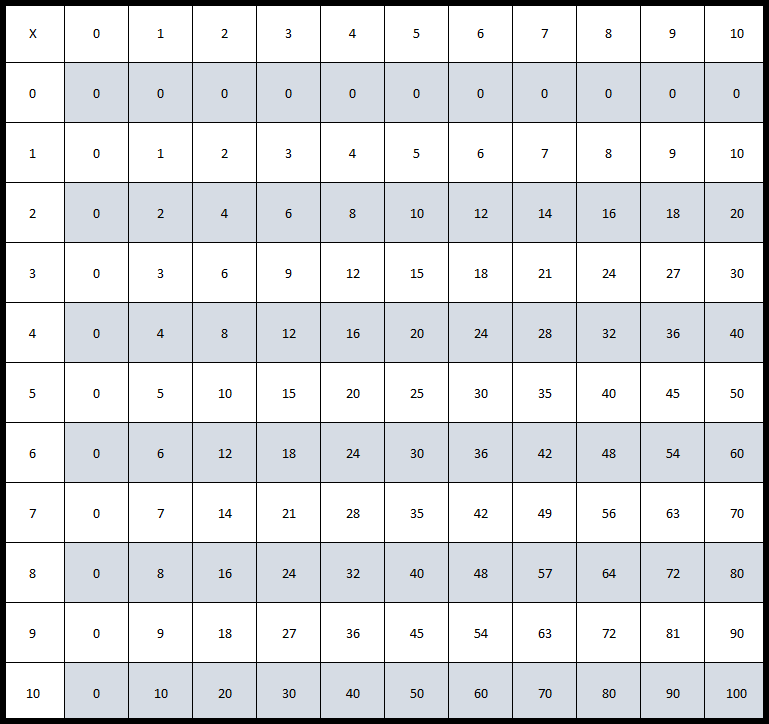
It’s a lot to take in, even for adults. But let’s look at how the multiplication table works.
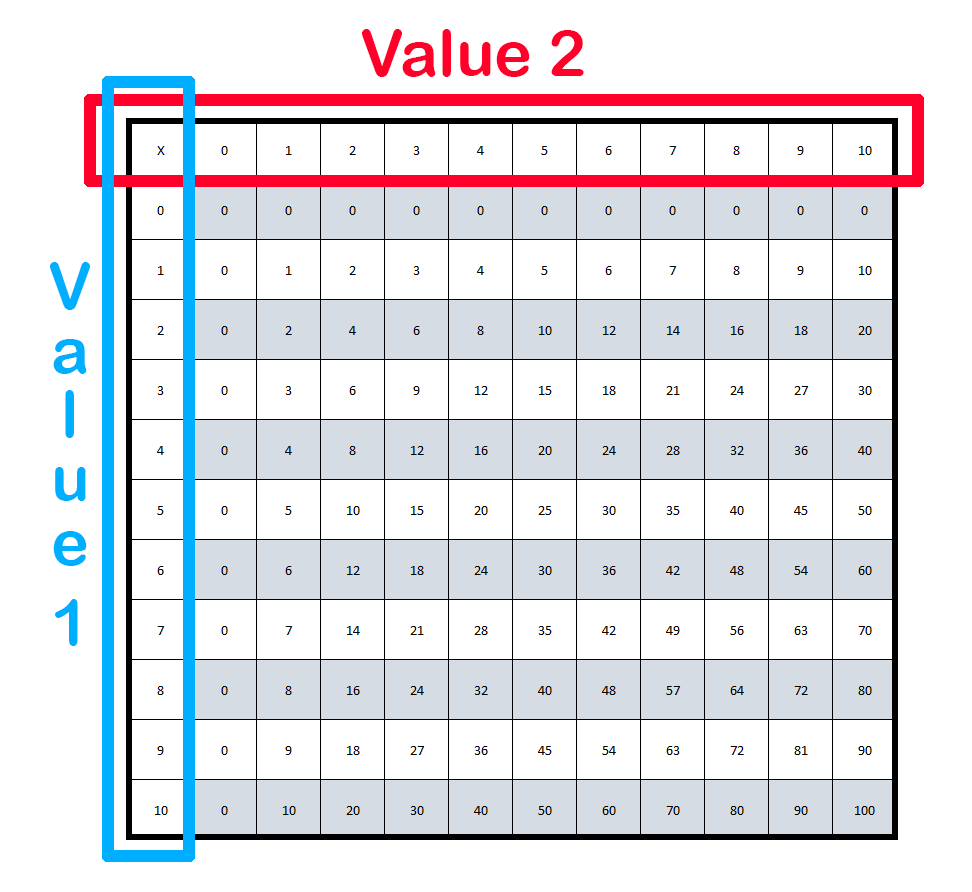
The multiplication table has two values associated with it. For the purposes of explaining, we have Value 1, which is the vertical column, and Value 2 which is the horizontal column.**
When you are looking up a multiplication value on the multiplication table, you are looking at (Value 1) x (Value 2). Let’s say we want to see what 5×10 is. In that case, we’d go to the 5 in Value 1 and the 10 in Value 2 and stop where they meet.
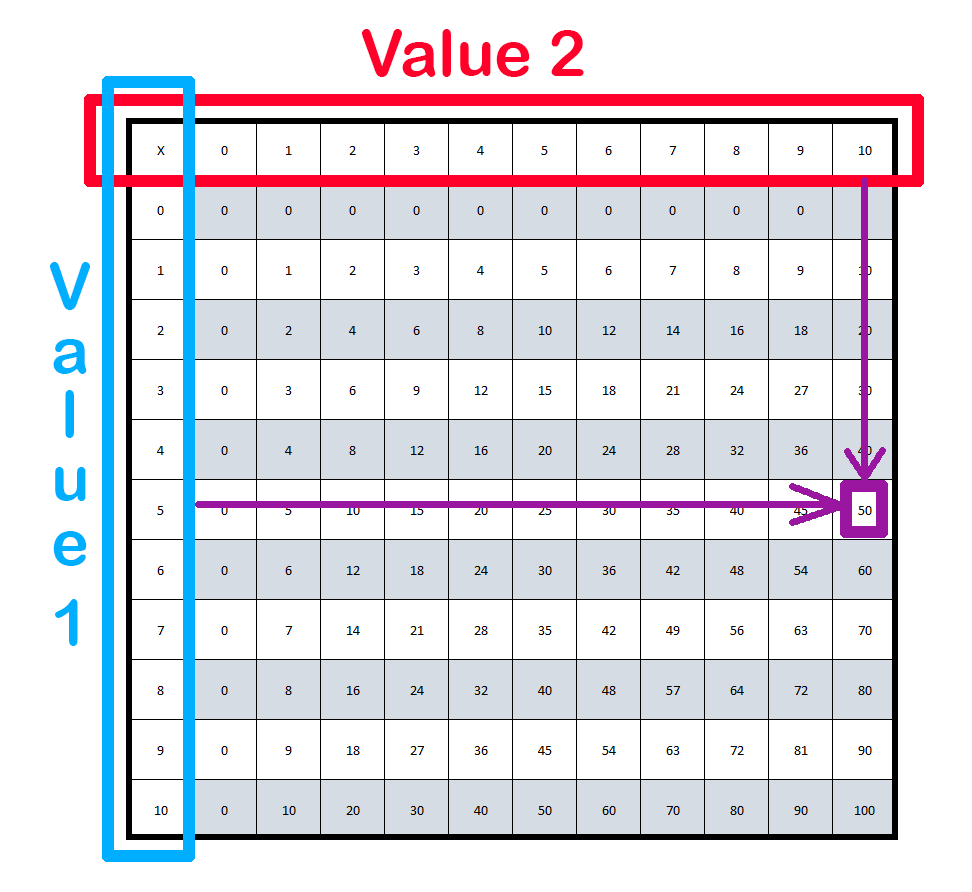
Going to where the two points meet, we can see that the answer is 50. Great! Now we’ve explained it to you, so how do you explain it to your child?
When you’re working with your child, using terminology like “Value” doesn’t really help them. Instead, call them “First number” and “Second number” and show them a blank equation such as this:

The first box holds the first number, and the second box holds the second number. When they encounter a multiplication problem, they just need to find the corresponding values to their multiplication table and trace with their fingers to find where the two meet. Easy, right?
**It doesn’t matter which Value is vertical or horizontal, just that you keep it consistent when teaching your kids. For our demonstration we’ve defined it as such.
Check out our downloadable PDF below where you can practice with your child!
Multiplication Table Worksheet

Numbers by themselves are just meaningless symbols. The reason we recognize that 5 is more than 3 is because we understand there is an attached value to these numbers. Developing this awareness of number values is something important for your children. It is one of the foundational blocks of mathematics and numerical understanding and reasoning.
When comparing numbers, we find ourselves at the K-5 level with 3 symbols.
<
>
=
< represents “Less than” as a sentence.
For example:
5<6
If we translate this into a sentence, we have: Five is less than six.
> represents “Greater than” as a sentence
For example:
8>3
If we translate this into a sentence, we have: Eight is greater than three.
= represents “is equal to” as a sentence
For example:
8=8
If we translate this into a sentence, we have “Eight is equal to eight
By itself, this is a relatively simple concept as an adult. However, for children, learning the difference between < and > is the same as learning that “d” and “b” are different letters. They are easily confused when first starting it. To help your child better understand and remember symbols, I remember how I was taught as a child : the symbols are alligators.
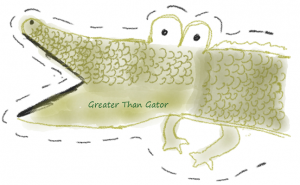
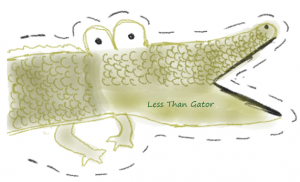
The idea is that the alligator is very hungry and wants to eat the bigger amount. If he is facing to the left, he wants to eat the left side. If he is facing to the right, he wants to eat the right side. So now, we’re back to the first question: how do we get our kids to understand bigger amounts?
Having objects to manipulate and use are extremely important for young learners. Giving them quantitative concepts without a physical representation in the world is setting them up for a much more difficult lesson than is necessary.
Take a look at the example below
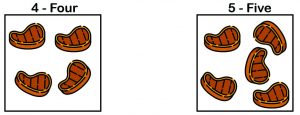
We have two numbers here. 4 and 5. You can ask your child which one the alligator wants to eat and remind them that the alligator will always eat the one that has more. Once they have chosen which alligator, have them speak out the sentence with the mathematical equations. In this case:
Four is less than five.
Five is greater than four.
Easy, right?
Use our printable PDF to play and learn with your child! In it, you will find cutouts of the alligators, different value boxes with foods inside them, and a few activity ideas.
Comparing Numbers Activity Sheet


Fraction bars are the first step that young learners see when being introduced to fractions. Sometimes, seeing a ¾ or a ⅓ may get confusing. Instead, a visual representation of a fraction with a fraction bar helps them to understand what a fraction is.
Let’s take a look at a simple fraction bar:

This fraction bar represents ¾
The shaded portion is what the numerator value is, and the total of the fraction bar represents the denominator value.
A numerator is the number on the top of a fraction. In the case of ¾, the numerator would be 3.
A denominator is the number on the bottom of a fraction. In the case of ¾, the denominator would be 4.
Numerators and denominators can still be somewhat confusing concepts. To help your child understand numerators and denominators better, it’s good to put it into a real-world example.
Let’s say this fraction bar is actually a candy bar. There are two parts of this candy bar:
The shaded portion represents how much we are going to share (the numerator), and the white part represents how many pieces of the candy bar there are in all (the denominator).
You can use a few exercises to help your child understand fractions with this example.
You can ask your child: how many pieces of the candy bar are going to be shared? They can count the shaded boxes to find out.
You can ask your child: how many pieces of the candy bar will be left? They can count the white boxes to find out.
You can ask your child: how many pieces of candy are there in all? They can count all of the boxes to find out.
Try it out with your child! Download the printable worksheet below.
Fraction Bar Interpretation Lesson Worksheet
Fraction Bar Interpretation Lesson Answer Key

Welcome to the Learn It 2 Earn It Lesson Resources!
The Lesson Resources are a series of blogposts that will be released every Friday at 17:00 PST. It will be a variety of activities and lessons you can use with your child at home, in addition to some perspectives on how to improve your child’s success when you are working with them.
Learn It 2 Earn It was built using common core curriculum standards. Although the CCCS is considered the basic skillsets that each student should be learning, we’ve noticed a trend in our userbase – they struggle with some of the concepts presented in the CCCS exercises we’ve created.
Finding ourselves in a new chapter of our lives in which digital learning has become the norm, there are new challenges facing every participant in a digital classroom. It becomes more difficult for students to get the guidance and support they may need from their teachers as they are no longer talking to someone in-person but instead someone on a screen in their homes.
We’ve decided to begin a series of lesson resources you can use to help your child maximize their learning, starting with guides that will not only help you to teach your child the concepts being presented to them in LI2EI and the classroom, but also help with adding some interactive activities for your child.
Our content director has spent over ten years teaching both within the US and internationally. What they noticed when they were teaching was the more pieces to a puzzle, the more parts to a game, the more activity involved in providing ownership for your child was always more successful in engaging children than just giving them worksheets to answer. Spending time to go over things with your child and also going through the activities in our worksheets will help your child feel more comfortable with math and also help set them up for success in the future.
If you see your child struggling with certain subjects in your parent dashboard, or you’re just here trying to find some help to give your child with their homework, check back on this blog periodically to see if some of the materials have been covered here to help support their learning.










